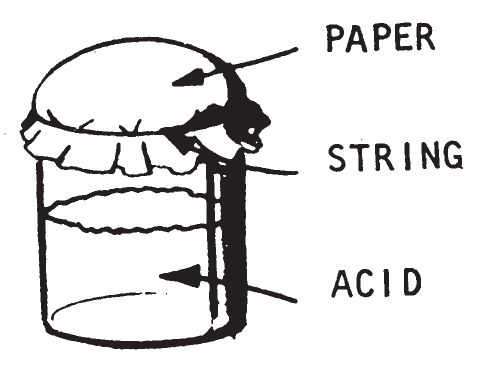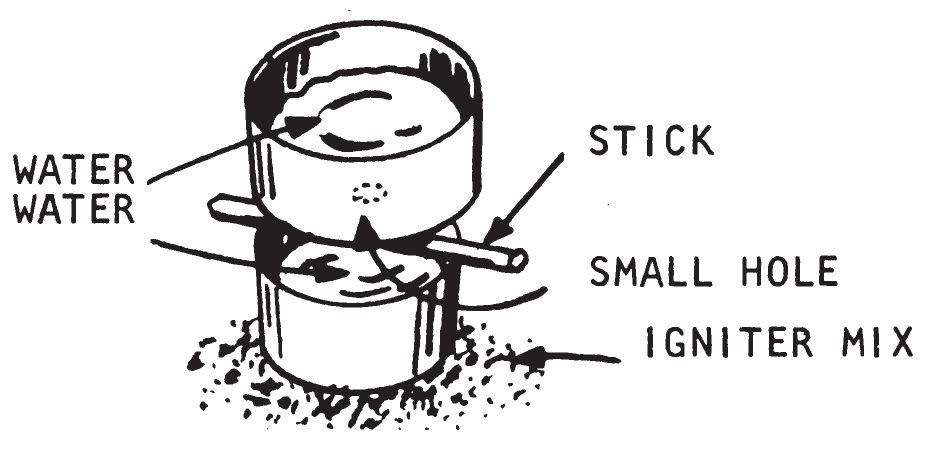Read U.S. Army Special Forces Guide to Unconventional Warfare Online
Authors: Department of the Army
U.S. Army Special Forces Guide to Unconventional Warfare (10 page)

a. Description.

This device consists of a half-full jar of concentrated sulfuric acid, and a paper diaphragm. The paper diaphragm is a piece of paper tied securely over the mouth of the jar. When the jar is placed on its side, the acid soaks through or corrodes the paper. The acid then contacts the igniter material and causes it to burts into flames. This delay can be used for initiating the following igniters listed in chapter 3: Sugar-Chlorate (0201), Fire Fudge (0202), SugarâSodium Peroxide (0203), Aluminum PowderâSodium Peroxide (0204), Match Head (0205), Silver NitrateâMagnesium Powder (0208).
b. Material and Equipment
Wide-mouthed jar.
Sulfuric acid (concentrated).
Paper.
String.
c. Preparation.
Remove the cap from a wide-mouthed jar Fill about half-full with concentrated sulfuric acid. Tie the paper securely over the mouth of the jar.
d. Application.
- Make a pile of dry flammable material such as rags, papers, empty boxes, or cartons. Spread out a piece of absorbent paper on this material. Spread igniter material on the absorbent paper and place the jar (on its side) on top of the igniter material. Make certain the jar does not leak. When the acid soaks through or corrodes the paper, it will contact the igniter material and cause it to burst into flame.

- This device is not reliable at temperatures below 40° F. The time delay depends on the thickness of the paper. A similar device should be tested to determine the delay provided by various thicknesses of paper. It should be tested at the temperature at which it will be used, to be sure of positive ignition. Ignition should occur in about 2 minutes at 68° F. when using writing paper. Higher ambient temperatures shorten delay times, and lower temperatures lengthen delay times.
a. Description.
- This device consists of potassium permanganate crystals wrapped in layers of absorbent paper. Glycerin is brought into contact with the wrapped potassium permanganate crystals by slowly soaking through the paper. This wets the wrapped crystals causing combustion. This delay can be used for directly initiating all igniters listed in chapter 3 except White Phosphorus (0209). The igniting ability of this delay is increased when magnesium or aluminum particles are mixed with the potassium permanganate crystals.
- The following incendiaries (ch 4) can be directly ignited using this delay: Napalm (0301), Gelled Gasoline (exotic thickeners) (0302), Gelled Gasoline (Improvised thickeners) (0303), Paraffin-Sawdust (0304), and Incendiary Brick (0309). Other combustible dry materials such as paper, rags, straw, and excelsior can also be directly initiated. This delay is not recommended for use in tempertures below 50° F.
b. Material and Equipment.
Absorbent paper (toilet paper, paper, toweling, newspaper).
Glycerin (commercial grade).
Magnesium or aluminum particles (consistency of granulated sugar).
Rubber bands or string.
Small shallow dish.
Potassium permanganate (consistency of coarse ground coffee).
Small bottle (approximately 1½ fluid ounces).
Spoon (perferably nonmetallic).
c. Preparation.
- Fill the small bottle with glycerin.
- Wrap a quantity of potassium permanganate crystals (a mixture of 85 parts potassium permanganate and 15 parts magnesium or aluminum particles can be substituted to produce a hotter flame) in absorbent paper. Make certain that none of the crystals fall out.
- The bottle and package may be carried by the person without hazard to himself, and will be available for use when needed.
d. Application.
- To use this delay, pour the glycerin into a small shallow dish or pan. Pile incendiary material around the dish so that when the glycerin ignites it will ignite the incendiary material. Place the paper container of potassium permanganate crystals into the pan of glycerin. When the glycerin soaks through the paper and contacts the potassium permanganate, ignition occurs within a few seconds.

- By using various kinds of paper, different delay times can be obtained. Using more layers of paper for wrapping will increase the delay time. Using this delay at higher temperatures will also decrease the delay time. Delay times from one minute to approximately one hour are possible, depending on the conditions.
- The delay time should be checked under conditions which are similar to those expected at the target.
a. Description.

This delay ignites flammable fuels of low volatility such as fuel oil and kerosene. A lighted candle properly inserted in a small container of flammable liquid of low volatility causes ignition of the flammable liquid when the flame burns down to the liquid level. The flame from the burning liquid is used to ignite incendiary material such as paper, straw, rags, and wooden structures. The delay time is reasonably accurate, and may be easily calibrated by determining the burning rate of the candle. No special skills are required to use this delay. Shielding is required for the candle when used in an area of strong winds or drafts. This delay is
not
recommended for use with
highly volatile liquids
because premature ignition may take place. This device is useful where a delay of one hour or longer is desired. The candle delay works well in cold or hot weather, and has the advantage of being consumed in the resulting fire, thus reducing evidence of arson.
b. Material and Equipment.
Candle.
Bowl.
Perforated can or carton.
Fuel oil or kerosene.
Matches.
Small piece of cloth.
c. Preparation.
- Make two marks on the side of the candle, 1½ inches and 2 inches from the top. Light the candle and record the times at which the wax melts at the marks on the side.

- The distance burned by the candle divided by the elapsed time determines the burning rate of the candle.
d. Application.
- Using a lighted candle of desired length, drip hot wax in the center of the bowl. Melt the base of the candle with a lighted match. Firmly press the softened base of the candle into the hot wax in the center of the bowl. Be sure the candle will stand up securely without toppling over. Extinguish the candle. Wrap a small piece of cloth around the candle and slide it down to the bottom of the bowl. Place a quantity of fuel oil or kerosene in the bowl. Be sure that the level of the fluid reaches the cloth, so it will act as a wick. Pile the incendiary material around the bowl where it can catch fire after the fuel oil or kerosene ignites.
- If this delay must be set in a windy or drafty location, place a shield over it. Notch or punch holes in a metal can or cardboard carton at the bottom and sides for ventilation, and place this cover over the delay.
a. Description.

This item provides a time delay in starting a fire. It consists of two tin cans, with tops removed, and uses either water or glycerin to activate the igniter material. A hole is punched in the closed end of one can. This can is placed on top of the other can which is partially filled with the liquid. The top can is completely filled with the liquid. When the bottom can fills and overflows, the overflowed liquid will react with the igniter material placed around the bottom can. This device is used for igniting the following water actuated igniters listed in chapter 3: SugarâSodium Peroxide (0203), Aluminum PowderâSodium Peroxide (0204), and Silver NitrateâMagnesium Powder (0208). Glycerin is used as the initiating liquid to ignite Potassium Permanganate glycerin (0206).
b. Material and Equipment.
Two tin cans.
Nail or punch.
Hammer.
Water or glycerin.
Can opener.
c. Preparation.
- Remove the tops from two cans.
- Punch or drill a small hole in the closed end of one of the cans.
- Partially fill the other can with either water or glycerin.
- Place the can with the hole in the bottom on top of the can partially filled with igniting fluid. Insert a twig or small stick between the two cans to allow the liquid to overflow from the bottom can.
- Fill the upper can with the same igniting fluid as that previously placed in the bottom can and determine the time required for the fluid to overflow from the bottom can. If two cans of the same size are used, either one may be used for the top. If different size cans are used, place the larger can on top. The delay is variable and adjustable depending on the sizes of the cans, the quantity of liquid used, or the diameter of the hole in the top can.
d. Application.
- Always test the glycerin delay at the temperature at which it will be used. Glycerin flows slowly when cold. Do not use water in this delay near or below its freezing point, 32° F.
- Place the delay in the target area and fill both upper and lower cans to the desired level with the appropriate liquid.
- Pile igniter material around the bottom of the overflow can so the activating liquid can easily make contact with the igniter material as it flows down the side of the can.
